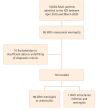Nosocomial meningitis in intensive care: a 10-year retrospective study and literature review
- PMID: 35081705
- PMCID: PMC8918708
- DOI: 10.4266/acc.2021.01151
Nosocomial meningitis in intensive care: a 10-year retrospective study and literature review
Abstract
Background: Nosocomial meningitis is a medical emergency that requires early diagnosis, prompt initiation of therapy, and frequent admission to the intensive care unit (ICU).
Methods: A retrospective study was conducted in adult patients diagnosed with nosocomial meningitis who required admission to the ICU between April 2010 and March 2020. Meningitis/ventriculitis and intracranial infection were defined according to Centers for Disease Control and Prevention guidelines.
Results: An incidence of 0.75% of nosocomial meningitis was observed among 70 patients. The mean patient age was 59 years and 34% were ≥65 years. Twenty-two percent of patients were in an immunocompromised state. A clear predisposing factor for nosocomial meningitis (traumatic brain injury, basal skull fracture, brain hemorrhage, central nervous system [CNS] invasive procedure or device) was present in 93% of patients. Fever was the most frequent clinical feature. A microbiological agent was identified in 30% of cases, of which 27% were bacteria, with a predominance of Gram-negative over Gram-positive. Complications developed in 47% of cases, 24% of patients were discharged with a Glasgow coma scale <14, and 37% died. There were no clear clinical predictors of complications. Advanced age (≥65 years old) and the presence of complications were associated with higher hospital mortality.
Conclusions: Nosocomial meningitis in critical care has a low incidence rate but high mortality and morbidity. In critical care patients with CNS-related risk factors, a high level of suspicion for meningitis is warranted, but diagnosis can be hindered by several confounding factors.
Keywords: bacterial meningitis; central nervous system infections; critical care; critical illness; healthcare-associated meningitis; hospital infection.
Conflict of interest statement
No potential conflict of interest relevant to this article was reported.
Figures
References
-
- Robinson CP, Busl KM. Meningitis and encephalitis management in the ICU. Curr Opin Crit Care. 2019;25:423–29. - PubMed
-
- Kurtaran B, Kuscu F, Ulu A, Inal AS, Komur S, Kibar F, et al. The causes of postoperative meningitis: the comparison of Gram-negative and Gram-positive pathogens. Turk Neurosurg. 2018;28:589–96. - PubMed
-
- Hussein K, Bitterman R, Shofty B, Paul M, Neuberger A. Management of post-neurosurgical meningitis: narrative review. Clin Microbiol Infect. 2017;23:621–8. - PubMed
-
- van de Beek D, Drake JM, Tunkel AR. Nosocomial bacterial meningitis. N Engl J Med. 2010;362:146–54. - PubMed
-
- Baer ET. Post-dural puncture bacterial meningitis. Anesthesiology. 2006;105:381–93. - PubMed
LinkOut - more resources
Full Text Sources
Miscellaneous


